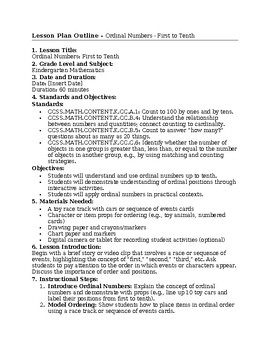Kindergarten Lesson Plan Outline - Ordinal Numbers - First to Tenth
Enhanced Education Resources
0 Followers
Grade Levels
K
Subjects
Resource Type
Standards
CCSSK.CC.A.1
CCSSK.CC.B.4
CCSSK.CC.B.5
CCSSK.CC.C.6
Formats Included
- Word Document File
Enhanced Education Resources
0 Followers
Description
Ordinal Numbers: First to Tenth
- Objective: Students will understand and use ordinal numbers up to tenth.
- Activity: Use a race track or sequence of events and have students place characters or items in order.
- Engagement: Play a "line-up" game where students must arrange themselves according to ordinal positions.
Standards:
- CCSS.MATH.CONTENT.K.CC.A.1: Count to 100 by ones and by tens.
- CCSS.MATH.CONTENT.K.CC.B.4: Understand the relationship between numbers and quantities; connect counting to cardinality.
- CCSS.MATH.CONTENT.K.CC.B.5: Count to answer “how many?” questions about as many as 20 things.
- CCSS.MATH.CONTENT.K.CC.C.6: Identify whether the number of objects in one group is greater than, less than, or equal to the number of objects in another group, e.g., by using matching and counting strategies.
Objectives:
- Students will understand and use ordinal numbers up to tenth.
- Students will demonstrate understanding of ordinal positions through interactive activities.
- Students will apply ordinal numbers in practical contexts.
Total Pages
Answer Key
N/A
Teaching Duration
1 hour
Report this resource to TPT
Reported resources will be reviewed by our team. Report this resource to let us know if this resource violates TPT’s content guidelines.
Standards
to see state-specific standards (only available in the US).
CCSSK.CC.A.1
Count to 100 by ones and by tens.
CCSSK.CC.B.4
Understand the relationship between numbers and quantities; connect counting to cardinality.
CCSSK.CC.B.5
Count to answer “how many?” questions about as many as 20 things arranged in a line, a rectangular array, or a circle, or as many as 10 things in a scattered configuration; given a number from 1-20, count out that many objects.
CCSSK.CC.C.6
Identify whether the number of objects in one group is greater than, less than, or equal to the number of objects in another group, e.g., by using matching and counting strategies.




